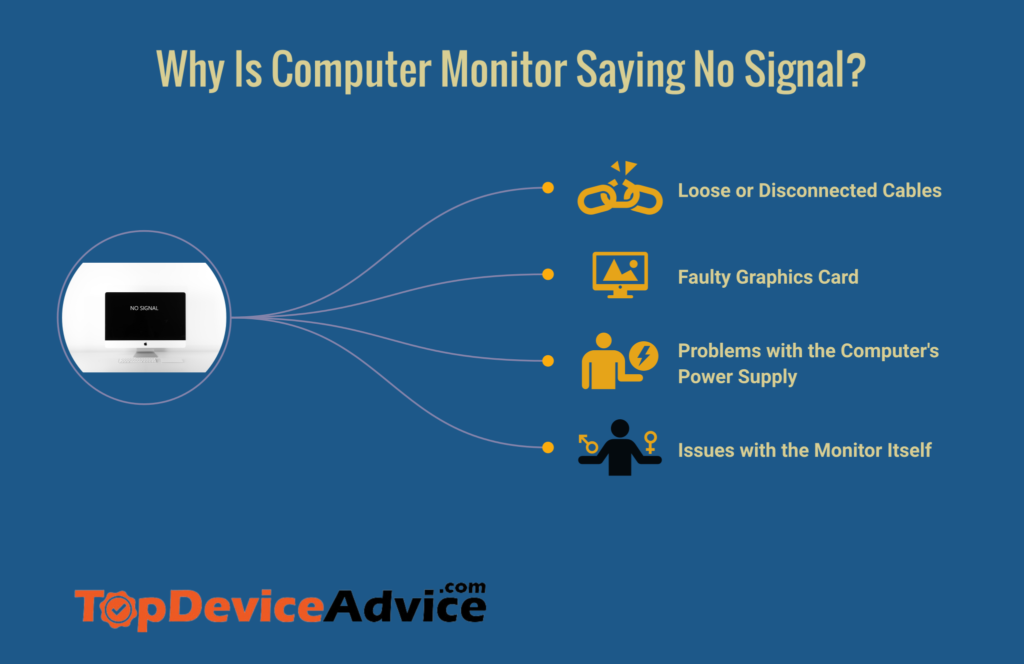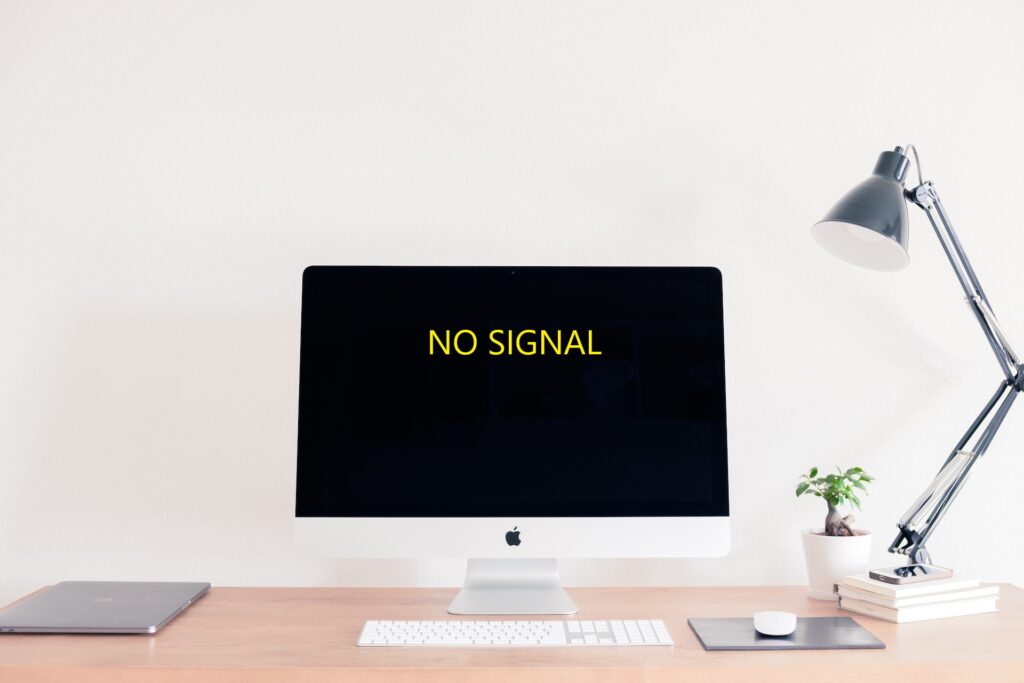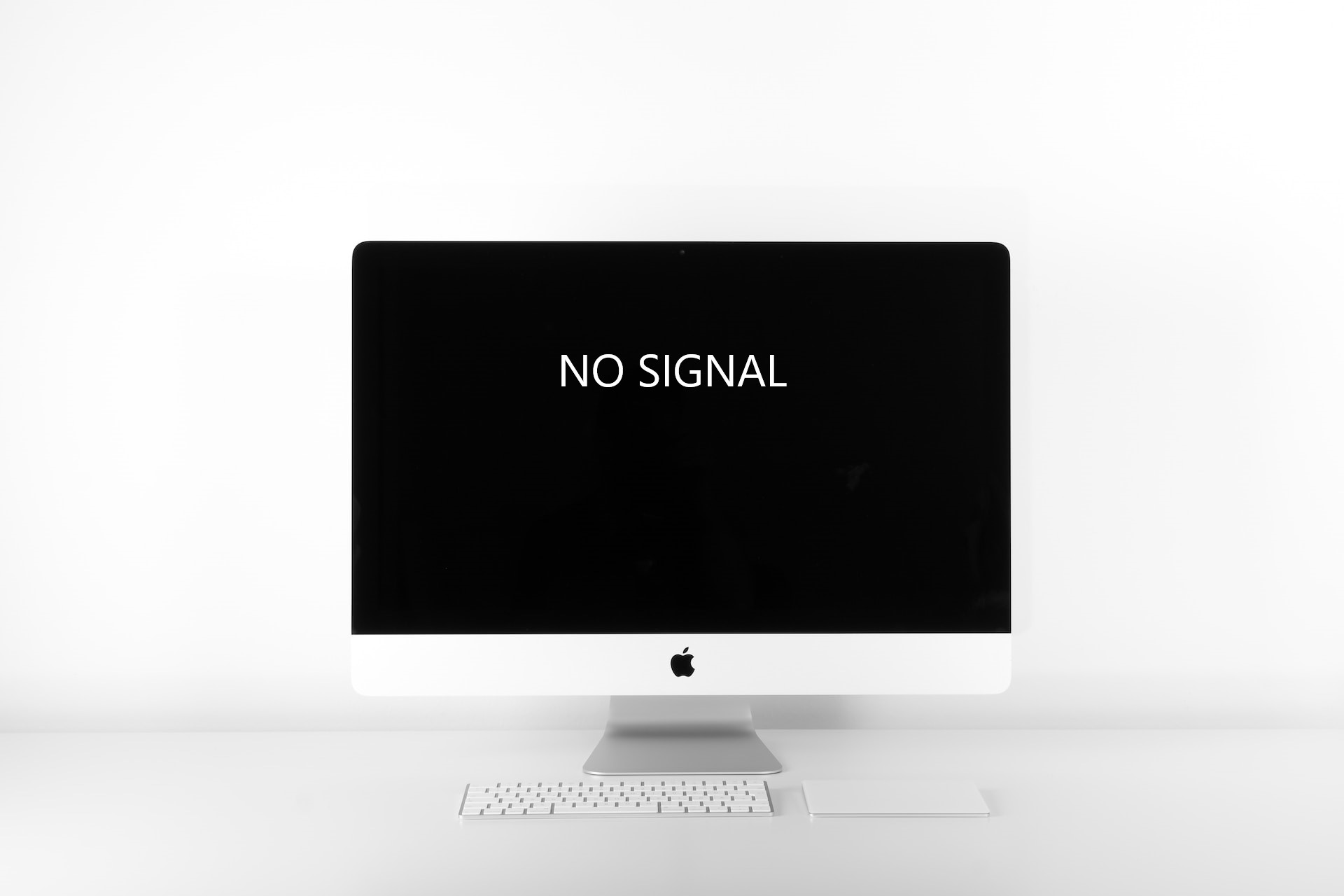Have you ever sat down to use your computer, and instead of the usual welcome screen, all you see is a computer monitor saying no signal? It’s like your computer monitor suddenly decided to stop communicating with you, isn’t it? You might wonder, “Why is my computer monitor saying No Signal?”
Well, this ‘No Signal on monitor but CPU running is simply your monitor’s way of telling you that it can’t receive or understand the information coming from your computer. Think of it like trying to listen to a radio station, but all you get is static – frustrating. The causes could range from something as simple as a loose cable to more complex issues like a problem with the graphics card (the part of your computer that handles all the images and videos).
But don’t worry! Once we understand the problem, we’re well on fixing it. So, let’s dive in and figure this out together.
Common Causes of Computer Monitor No Signal

So, how do you fix the ‘No Signal’ message? The first step is to figure out what’s causing it. Here are some of the most common causes:
☑Loose or Disconnected Cables
Loose or disconnected cables are among the most common causes of a ‘No Signal’ message. Imagine this: your computer and monitor are trying to chat, but if their connection (the cable) is loose or unplugged, they can’t communicate! So, always check to make sure that all cables are securely connected.
☑Faulty Graphics Card
Next on the list is a faulty graphics card. Think of the graphics card as the creative genius in your computer that paints all the images you see on your screen. If this artist isn’t feeling well (i.e., the graphics card is faulty), then your monitor won’t be able to display any of those masterpieces.
☑Issues with the Monitor Itself
Sometimes, the problem lies with the monitor itself. It’s like trying to listen to your favorite song through broken speakers – no matter how much you try, you just won’t hear anything. Similarly, if the monitor is having issues, it won’t be able to display anything from your computer, resulting in a ‘No Signal’ message.
☑Problems with the Computer’s Power Supply
A “No Signal’ message could be due to problems with your computer’s power supply. Imagine trying to chat with a friend when you’re extremely tired – keeping the conversation going is hard, right? The same goes for your computer. It might struggle to send signals to the monitor if it’s not getting enough power.
Remember, a ‘No Signal’ message is not the end of the world! Once we identify the cause, finding a solution becomes much easier.
How to Troubleshoot ‘No Signal’ Message

Once you identify the cause of the ‘No Signal’ message, it’s time to take action. Here are some troubleshooting tips:
✔️Checking the Cables
The first step in troubleshooting a ‘No Signal’ message is to check your cables. Ensure all cables are securely plugged in at both ends and aren’t visibly damaged or frayed. It’s also important to use the correct cables – using an incompatible cable could be like speaking a language your computer doesn’t understand!
✔️Testing the Graphics Card
The next step is to test your graphics card. One way to do this is to connect your monitor to another computer. If the monitor works with a different computer, then it’s likely that your graphics card is the culprit. A possible solution could be updating the graphics card drivers; in some cases, you might need to replace the graphics card entirely.
✔️Inspecting the Monitor
Next, inspect your monitor. Check for any obvious signs of damage, like cracks or discoloration. Connect your monitor to another device, like a laptop or a different computer. The issue might be with the monitor itself if it still displays the ‘No Signal’ message. Regular care and maintenance, like keeping your monitor clean and avoiding harsh physical impacts, can help prolong its lifespan.
✔️Assessing the Power Supply
Lastly, assess your computer’s power supply. If your computer isn’t turning on or shutting down unexpectedly, the power supply might be the issue. Ensure your computer is plugged into a working outlet and the power cord isn’t damaged. To maintain a healthy power supply, avoid overloading your computer with too many tasks at once, and ensure that it’s kept in a cool, dry environment to prevent overheating.
Remember, troubleshooting a ‘No Signal’ message can take some time and patience, but once you identify the issue, finding a solution becomes much easier!
When to Seek Professional Help
There are certain indications that it’s time to consult a professional when dealing with a ‘No Signal’ message. If you’ve tried all the troubleshooting tips and your monitor still isn’t working, or if there’s visible damage to your monitor, graphics card, or cables, it’s best to seek professional help. Computers can be complex, and attempting to fix issues beyond your knowledge could lead to further damage.
Risks of DIY Fixes
While trying and resolving minor issues on your own is great, attempting to fix serious problems without the necessary expertise can lead to more harm than good. You could accidentally damage sensitive components, void your warranty, or even put yourself at risk of electrical shock. Therefore, if the issue seems serious and is not something you’re comfortable handling, it’s always safer and potentially more cost-effective in the long run to consult a professional.
Preventive Measures to Avoid ‘No Signal’ Message

The best way to avoid a ‘No Signal’ message is to take preventive measures. Here are some tips:
✅Regular Maintenance Checks
Just like a car or any other piece of machinery, your computer system requires regular check-ups to ensure it’s running smoothly. It includes keeping all software up to date, cleaning dust from your computer’s interior to prevent overheating, and regularly scanning for viruses. These maintenance checks can help you spot potential issues before they lead to a ‘No Signal’ message.
✅Proper Handling and Use of the Computer System
How you handle and use your computer system can also impact its health. Avoid eating or drinking near your computer to prevent spills, and avoid blocking any ventilation outlets to prevent overheating. Additionally, regularly shutting down your computer instead of leaving it in sleep mode can help prolong its lifespan.
✅Investing in Quality and Compatible Hardware
Investing in quality and compatible hardware can go a long way in preventing a ‘No Signal’ message. This means choosing cables, monitors, and graphics cards that are compatible with your computer system and are from reputable brands. While it might be tempting to save money by going for cheaper options, these could cost you more in the long run if they fail or cause damage to your system.
Remember, prevention is always better than cure. By following these preventive measures, you can reduce the chances of encountering a ‘No Signal’ message and ensure a longer, healthier life for your computer system.
Frequently Asked Questions
1. What should I do if my monitor displays “No Signal” after a power outage?
After a power outage, your monitor might display a “No Signal” message due to improper shutdown or power surge. To fix this, ensure your computer is properly powered on. If it is, try unplugging the power cable from both the monitor and the wall socket, wait for a few minutes, and then plug them back in. This process resets the monitor and can help resolve the issue1.
2. How can I fix the “No Signal” problem using multiple monitors?
If you’re using multiple monitors and encounter a “No Signal” error, verify that your graphics card supports multiple monitors. Ensure all cables are properly connected, and each monitor is correctly set up in your display settings. If one monitor still shows “No Signal,” try swapping the cables or using a different port on the graphics card to rule out any hardware issues.
3. Can a defective HDMI or DisplayPort cable result in a “No Signal” error?
A faulty HDMI or DisplayPort cable can cause a “No Signal” error. These cables transmit the signal from your computer to your monitor; if they’re damaged or malfunctioning, they won’t be able to carry the signal effectively. Try using a different cable to see if this resolves the issue.
4. Is it possible for a damaged graphics card to cause the “No Signal” issue?
Absolutely. The graphics card is responsible for sending visual information to the monitor. If it’s damaged, it won’t be able to send these signals, resulting in a “No Signal” message. If you suspect a damaged graphics card, you may need to consult a professional or consider replacing the card.
5. What should I do if my monitor says “No Signal” even though my computer is powered on?
First, ensure all cables are properly connected. If they are, try to restart your computer. Sometimes, a simple reboot can solve the issue. If the problem persists, it might be due to a faulty cable, a malfunctioning port, or an issue with your graphics card. You can try using different cables or ports or testing with another monitor to identify the cause.
Final Words
In the end, I found out why my computer monitor was constantly saying “no signal.” It was because the cable connecting my monitor to my computer was loose. Once I tightened the connection, my computer could finally display what was on its screen. This experience taught me that sometimes the solution to a problem can be as simple as ensuring everything is properly connected.
It’s essential to not get too overwhelmed when something goes wrong and to take a step back and approach the situation with a clear and logical mindset. However, we might not have the same issues; you can check the tips above and hopefully prevent or resolve the “No Signal” error in the future.

